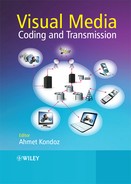10.5 Conclusions
This work has examined issues involved with QoS mapping. The idea of QoS mapping can be interpreted in a number of different ways, making it important to define the interpretation used in this document. In the interpretation used here, it is assumed that in a real communications scenario, two different mobile network types, possibly owned by two different network operators, are connected by a core network. It should be noted that there are no direct relays between the two mobile networks. This means that the two networks must be configured separately. The intention of the work delineated here has been to generate a set of performance curves with different QoS parameter settings over a range of different channel conditions that might be experienced in a mobile network. These curves will enable network operators to configure their systems in an optimized manner.
QoS parameter mapping for video transmission over an EDGE-to-UMTS system have been investigated by means of system emulation. The QoS mapping emulation system is built to evaluate the effect when an EGPRS network user transmits videos to a user in a different network such as UMTS, and vice versa. The system consists of five components: MPEG-4 file transmitter, EGPRS emulator, QoS mapping emulator, UMTS emulator, and MPEG-4 decoder. EGPRS and UMTS emulators have been developed to support communication with other emulators. The QoS mapping emulator acts as a bridge between the EGPRS emulator and the UMTS emulator. A new MPEG-4 Terminal program, which has a mobile-phone shape, combines the functions of the MPEG-4 file transmitter and the MPEG-4 decoder. The intention of the emulator design is to enable investigation of optimal QoS settings when transmitting video between two different network types. The results give service providers and network operators a set of performance figures with different combinations of QoS parameters in two different networks, over a range of channel conditions. These performance figures can be used in QoS parameter selection in real networks.
The experiment has shown that the video quality for EDGE-to-UMTS network transmission is lower than for EDGE-to-EDGE or UMTS-to-UMTS transmission, due to parameter mismatch between the two networks. If the QoS of the video transmission in a single network is poor, the network parameters on the second connection should be carefully selected to avoid further quality degradation. Otherwise, the received quality will be unacceptable to the end user. There are many different possible combinations of channel conditions and scenarios that might be encountered in real networks. Therefore, it is not possible to give a short guide to the best possible set of parameters to use. Instead, the data from these simulations could be used to construct a further software package, capable of producing a set of optimized UMTS parameters given certain EDGE parameter inputs.
